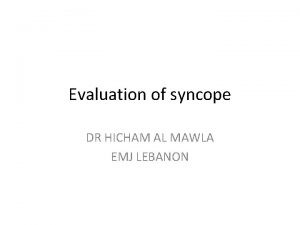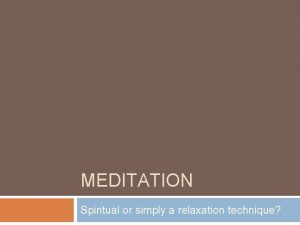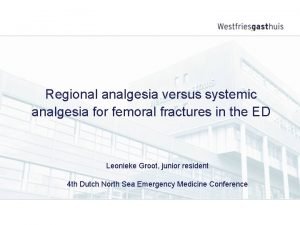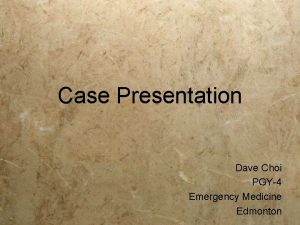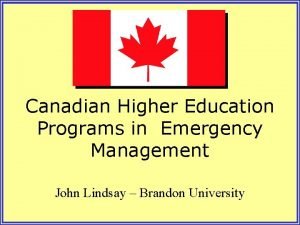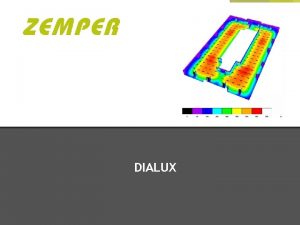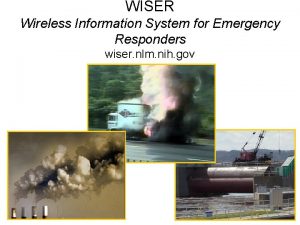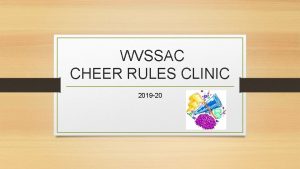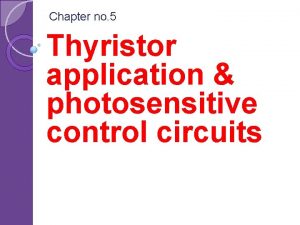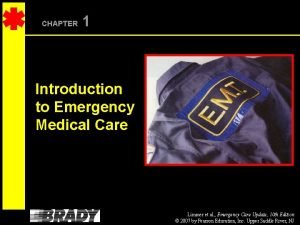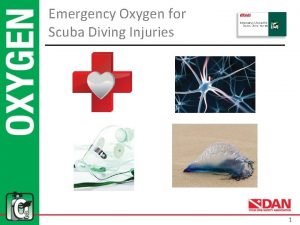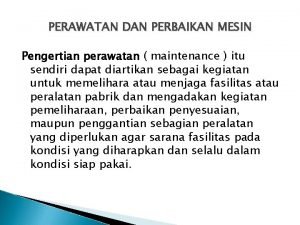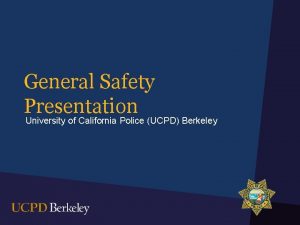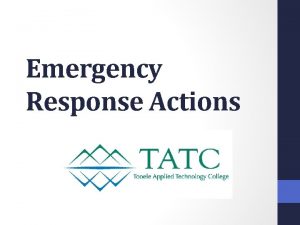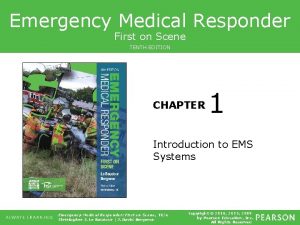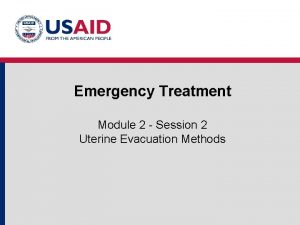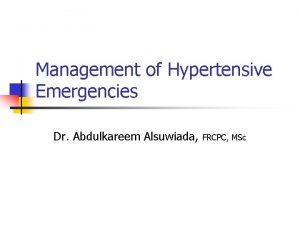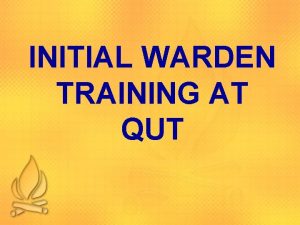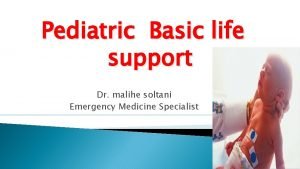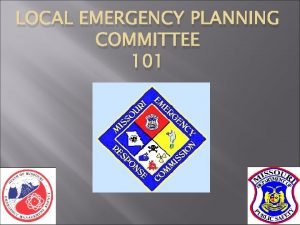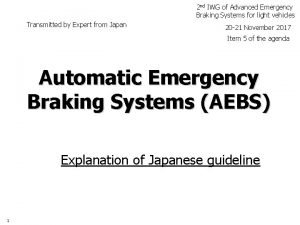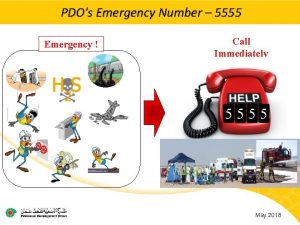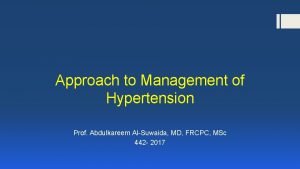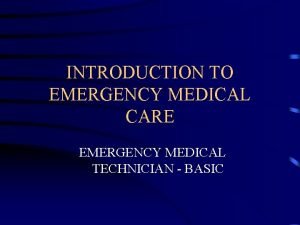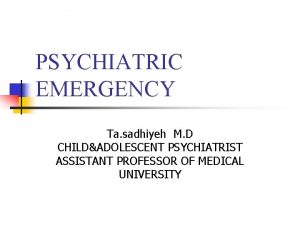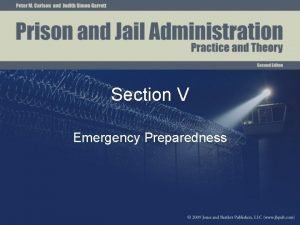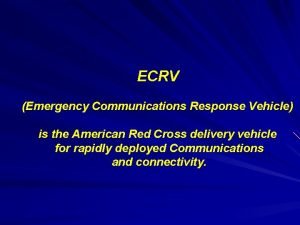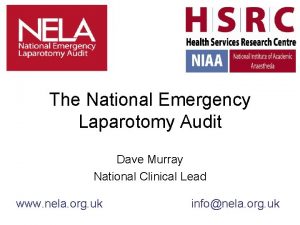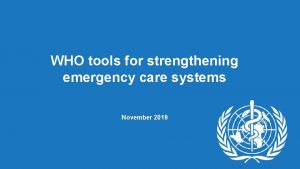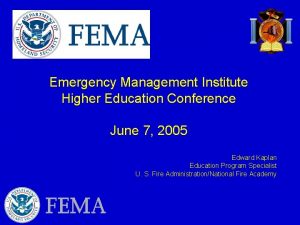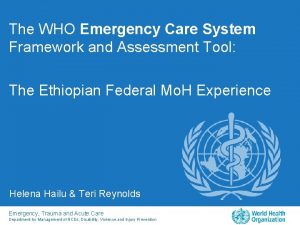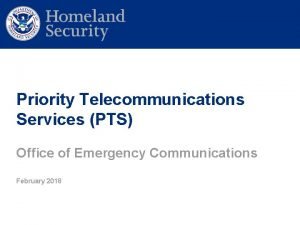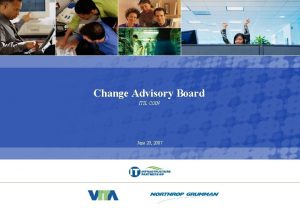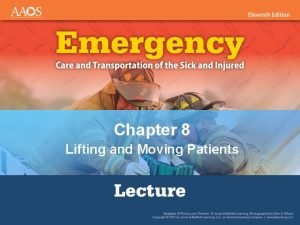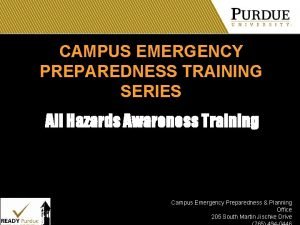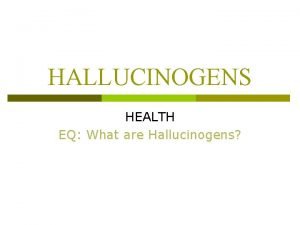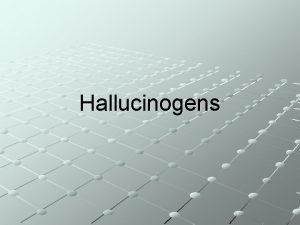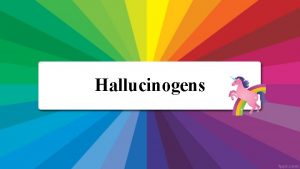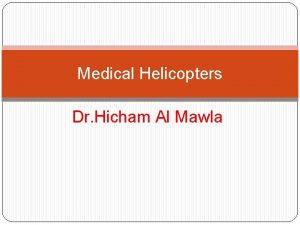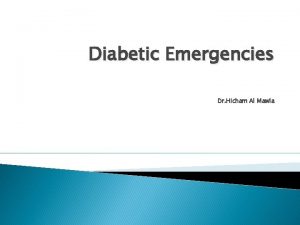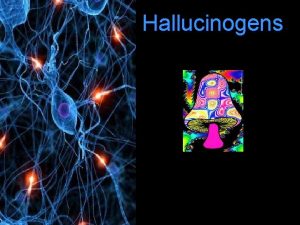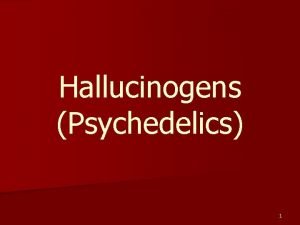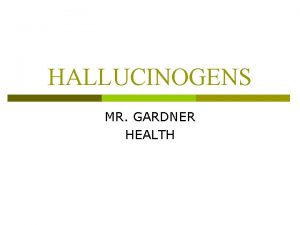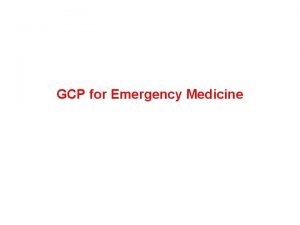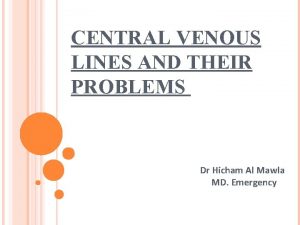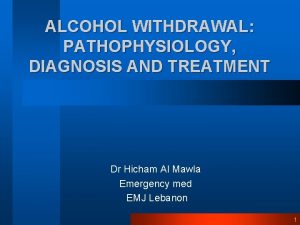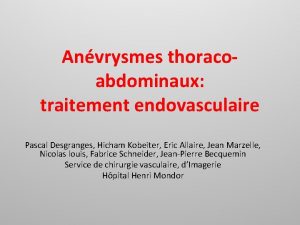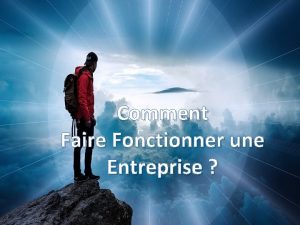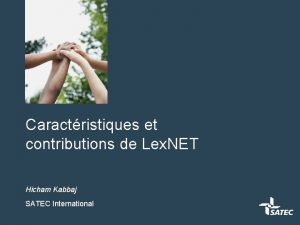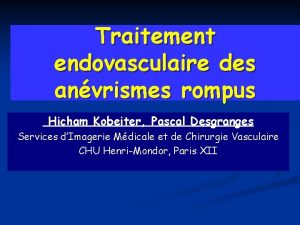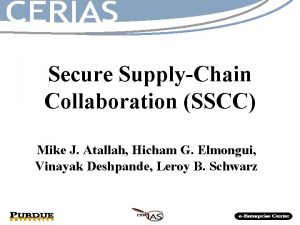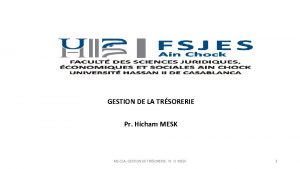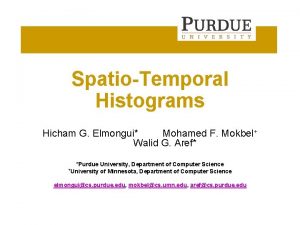Hallucinogens Dr Hicham Mawla Emergency Medicine Hallucinogens Hallucinogens















































- Slides: 47

Hallucinogens Dr. Hicham. Mawla Emergency Medicine

Hallucinogens • Hallucinogens are substances that alter sensory processing in the brain, causing perceptual disturbances, changes in thought processing, and depersonalization

Modern Day History of Hallucinogens Vietnam War Timothy Leary Harvard professor The Psychedelic Experience

The Nature of Hallucinogens • Many drugs can exert hallucinogenic effects related to neurotransmitters: Serotonin: LSD, psilocybin, DMT Norepinephrine: amphetamine related, mescaline, MDMA Acetylcholine: atropine, scopolamine Dissociative anesthetics: PCP, ketamine

Names for Hallucinogens Psychedelic Psychotogenic Psychotomimetic

Sensory and Psychological Effects Altered perception. - Synesthesia: blending of the senses. Perceptual changes. Self-reflection - “Make conscious the unconscious” Loss of identity and cosmic merging - “Mystical-spiritual aspect of the drug experience” Aldous Huxley: Doors of Perception.

LSD class drugs LSD, mescaline, psilocybin, DMT, bufotenine Primarily act on Serotonin receptors Frontal cortex and limbic system Also act on raphe nucleus which functions to filter incoming sensory stimuli Disrupts the sorting process Flood of sensations and perceptions

LSD-class Hallucinogens LSD Types of Agents These drugs cause predominantly psychedelic effects. Of high school seniors sampled: - 1999— 12. 2% had used LSD sometime during life - 2002— 8. 4% had used LSD sometime during life Albert Hofmann and LSD model

LSD Physical Effects LSD Types of Agents Physiological effects: - Massive increase in neural activity in some brain regions - Activates sympathetic nervous system (rise in body temperature, heart rate, and blood pressure) - Parasympathetic nervous system (increase in salivation and nausea)

LSD Timeline • About half of the substance is cleared from the body within 3 hours, and more than 90% is excreted within 24 hours. Effects of this hallucinogen can last 2– 12 hours. Tolerance to the effects of LSD develops very quickly.

Psilocybin • Psilocybin—its principal source is the Psilocybe mexicana mushroom. It is not very common on the street. Hallucinogenic effects produced are quite similar to LSD. Cross-tolerance among psilocybin, LSD, mescaline. Stimulates the autonomic nervous system, dilates the pupils, increases the body temperature

Psilocybe Mushrooms Small brown mushrooms that stain blue to the touch Illicit cultivation but also foraged from temperate climates

Psilocybe Mushrooms: Religious Use Religious use continues in Oaxaca, Mexico

Dimethyltryptamine (DMT) - A short-acting hallucinogen - Found in seeds of certain leguminous trees and prepared synthetically. - It is inhaled and similar action as psilocybin. - High doses can be quite intoxicating. - Can also cause unpleasant reactions/.

DMT…it’s as common as crabgrass… “Canary” grass; Phalaris aquatica, P. arundinacea, P. canariensis, P. tuberosa Desmanthus illinoensis; Prairie Bundleflower Many other sources; mostly S. America.

Phalaris (DMT source)

Desmanthus illinoesis (DMT Source)

Bufo Frogs… Contains bufontinin but intoxication primarily from 5 -Meo-DMT The toad is NOT licked but glands are milked for poison

Amphetamine Class Mescaline Synthetic amphetamine derivatives (DOM, MDA, MDMA) Act on dopamine and serotonin

Amphetamine Hallucinogens Drugs are chemically related to amphetamines. They have varying degrees of hallucinogenic and CNS stimulant effects. - Release serotonin are dominated by their hallucinogenic action - Release dopamine are dominated by their stimulant effects

Amphetamine Hallucinogens Mescaline “Designer” amphetamines 3, 4 Methylenedioxyamphetamine (MDA) Methylenedioxymethamphetamine (MDMA, Ecstasy)

Ephedra of the US E. trifurca, E. viridis, E. torreyana, E. nevadensis and E. californica 100 gm dried ephedra could contain anywhere from 0 to 2. 6 gm of ephedrine.

Ephedra grows in the deserts of the Southwest

Mescaline - Mescaline is the most active drug in peyote cactus; it induces intensified perception of colors and euphoria - Effects include dilation of the pupils, increase in body temperature, anxiety, visual hallucinations, and alteration of body image, vomiting, muscular relaxation. Very high doses may cause death. - Street samples are rarely authentic.

Peyote Lophophoria williamsii contains 1. 5% mescaline (b 3, 4, 5 -trimethoxyphenethylamine) 3 mg/kg potent intoxication Up to 8 to 10 hour duration Continued religious use in North America Other cacti used in South America and also…

Harvesting Peyote

Natural Range of Peyote

The Peyote Ceremony Stewart OC. Peyote Religion. Norman, OK: University of Oklahoma Press, 1987. Aberle DF. The Peyote Religion Among the Navaho. Chicago, IL: Aldine Publishing Co. , 1966.

MDMA (‘Ecstasy’)

Psychostimulants The most common psychostimulants (cocaine, MDMA and amphetamine) act on the synapse to increase the activity of dopamine, noradrenaline and serotonin. Cocaine blocks pre-synaptic reuptake

MDMA (‘Ecstasy’) A synthetic amphetamine derivative, usually sold as small tablets or capsules Many tablets sold as ecstasy also contain other chemicals including: ketamine, GHB, amphetamine, caffeine. A recent study (Baggott et al 2000) found that: n n n 63% contained MDMA 29% contained other substances (e. g. caffeine, psuedoephedrine) 8% contained no MDMA

MDMA (‘Ecstasy’): Effects Immediate sought after-effects, 4 -6 hours in duration n euphoria, increased confidence, increased perception of closeness to others, visual hallucinations Negative effects n jaw clenching, anxiety, paranoia, insomnia, dry mouth, increased body temperature

Party drug culture High levels of activity: hydration and hyperthermia Poly-drug use, illicit and misuse of prescribed substances: n n Viagra used primarily within the gay community Anti-depressants and benzodiazepines thought to increase the ‘high’ or relieve the ‘come down’ associated with party drug use

Risks of Ecstasy Toxicity: MDMA overdose is rare n associated with intense sympathomimetic responses and active hallucinations as well as thermoregulatory, neurologic, cardiovascular, hepatic and electrolyte disturbances (Gowing et al 2002). Risks of adulterants Dependence syndrome (occasionally) Some evidence of cognitive impairment as a result of long term use (Kalant, 2001) Association between long-term MDMA use and emotional disturbance (depression).

Anticholinergics Attach to Ach receptors and act as antagonists Found in Belladonna, Nightshade, Jimsonweed and Mandrake plants

Ach Antagonists Plants containing scopolamine Low doses produce amnesia, fatigue, mental confusion, dreamless sleep and loss of attention High doses: Hallucinations, paralysis of respiratory system, coma, and death. Side Effects: increase in sympathetic activity Hot as a hare, dry as a bone, red as a beet, and mad as a hen

Datura stramonium Leaves typically cut and smoked Contains atropine, scopalomine Ancient ceremonial use in the U. S. Occasional report of death by ingestion of root Many other sources for atropine and scopalomine Member of Nightshade family “Jimson weed”

Dissociative Drugs PCP (phencyclidine) Ketamine Dextromethorphan

• Phencyclidine (PCP) It was developed as an intravenous anesthetic, but found to have serious adverse side effects. It differs from the other traditional hallucinogens. It is a general anesthetic in high doses. It causes incredible strength and extreme violent behavior. Management of the severe psychological reactions requires drug therapy.

PCP physiological effects - Hallucinogenic effects, stimulation, depression, anesthesia, analgesia - Large doses can cause coma, convulsions, and death. PCP psychological effects - Feelings of strength, power, invulnerability; perceptual distortions, paranoia, violence, Potential for psychotic break.

Ketamine (“Special K”) v. Anesthetic developed to replace PCP, manufactured by Pfizer v. Used in human and veterinary medicine v. Injected or dried and snorted v. Feelings of floating, or sometimes terrifying “bad trip” called “K hole” v“Vitamin K” v“Bump”

DXM (dextromethorphan) Cough suppressant v(Also used to boost effects of analgesics for severe pain) v. Typical dose 15 -30 mg. for cough v 4 or more ounces may cause distorted visual perceptions, similar effects to PCP and Ketamine v“Robo” v. Internet groups to discuss “Robo-ing”

Statistics on Use National Survey on Drug Use and Health (2004 & 2005) Monitoring the Future (National Survey) (2005) Drug Abuse Warning Network (DAWN)

NSDUH Hallucinogen Statistics Percentages of Past Year Hallucinogen Use among Persons Aged 12 or Older, by Age Group: 2004 and 2005

Monitoring the Future Hallucinogens 2005 8 th 10 th 12 th Psychedelics 2. 4 4. 0 5. 5 LSD 1. 2 1. 5 1. 8 Others 2. 0 3. 5 5. 0

Hallucinogens in ER Visits, 2005 Drug-Related ER Visits DAWN Hospitals Cocaine 448, 481 Heroin 164, 572 Ketamine 275 LSD 1, 864 PCP 7, 535 Misc. hallucinogens 3, 792

AAPCC Annual Report 2005 Substance Number of human exposures reported to US Poison Control Centers Hallucinogenic mushrooms 849 Muscarine mushrooms 19 Hallucinogenic plants 355 Solanine plants (nightshade family) 1, 166 Ketamine 161 Dextromethorphan (APA/ASA) 67, 038. 00 Hallucinogens (general, various) 1, 924 Mescaline/peyote 102 PCP 662 2005 Annual Report of the American Association of Poison Control Centers’ National Poisoning and Exposure Database. Clinical Toxicology, 44: 803 -932, 2006
 Al-mawla
Al-mawla Hallucinogens def
Hallucinogens def Dutch north sea emergency medicine conference
Dutch north sea emergency medicine conference Unm im residency
Unm im residency Cmc vellore emergency medicine
Cmc vellore emergency medicine University of arizona emergency medicine
University of arizona emergency medicine Emergency medicine case presentation
Emergency medicine case presentation Canadian emergency management college
Canadian emergency management college National emergency services academy
National emergency services academy Dialux emergency lighting tutorial
Dialux emergency lighting tutorial Wiser artinya
Wiser artinya Wvssac emergency action plan
Wvssac emergency action plan Emergency index
Emergency index Phase control triac
Phase control triac Emergency care limmer
Emergency care limmer Delivery system components scuba
Delivery system components scuba Pengertian running maintenance
Pengertian running maintenance Ucpd non emergency
Ucpd non emergency Pps emergency signals and actions
Pps emergency signals and actions Emergency medical responder first on scene
Emergency medical responder first on scene Prehospital care 11th edition
Prehospital care 11th edition Emergency evacuation training
Emergency evacuation training Htn emergency vs urgency
Htn emergency vs urgency Durham county emergency management
Durham county emergency management Qut security emergency extension number
Qut security emergency extension number Pediatric emergency life support
Pediatric emergency life support Emergency lighting design nz
Emergency lighting design nz Missouri emergency response commission
Missouri emergency response commission Emergency braking preparation
Emergency braking preparation Emergency action plan lifeguard
Emergency action plan lifeguard Urgent treatment centre whittington
Urgent treatment centre whittington Pdo emergency number
Pdo emergency number Htn emergency vs urgency
Htn emergency vs urgency Tdh ems
Tdh ems Disaster vector
Disaster vector Psychiatric emergencies
Psychiatric emergencies Chapter 36 emergency preparedness and protective practices
Chapter 36 emergency preparedness and protective practices Emergency communications response vehicle
Emergency communications response vehicle National emergency laparotomy audit
National emergency laparotomy audit Emergency care system framework
Emergency care system framework Chapter 36 emergency preparedness and protective practices
Chapter 36 emergency preparedness and protective practices Emergency management institute
Emergency management institute Who emergency care system framework
Who emergency care system framework Pts
Pts Change advisory board
Change advisory board Emergency contact list
Emergency contact list Diamond carry ems
Diamond carry ems Purdue emergency alerts
Purdue emergency alerts
